2016 California Standards for Accessible Design Pocket Guide - Eff. Jan. 1, 2017
11B-502 Parking spaces.
11B-502.1 General.
Car and van parking spaces shall comply with Section 11B-502. Where parking spaces are marked with lines, width measurements of parking spaces and access aisles shall be made from the centerline of the markings.
Exception: Where parking spaces or access aisles are not adjacent to another parking space or access aisle, measurements shall be permitted to include the full width of the line defining the parking space or access aisle.
11B-502.2 Vehicle spaces.
Car and van parking spaces shall be 216 inches (5486 mm) long minimum. Car parking spaces shall be 108 inches (2743 mm) wide minimum and van parking spaces shall be 144 inches (3658 mm) wide minimum, shall be marked to define the width, and shall have an adjacent access aisle complying with Section 11B-502.3.
[2010 ADAS] 502.2 Vehicle Spaces. Car parking spaces shall be 96 inches (2440 mm) wide minimum and van parking spaces shall be 132 inches wide minimum, shall be marked to define the width, and shall have an adjacent access aisle complying with 502.3.
Exception: Van parking spaces shall be permitted to be 108 inches (2743 mm) wide minimum where the access aisle is 96 inches (2438 mm) wide minimum.
[2010 ADAS] EXCEPTION: Van parking spaces shall be permitted to be 96 inches (2440 mm) wide minimum where the access aisle is 96 inches (2440 mm) wide minimum.
ETA Editor's Note
The CBC dimensional requirements for accessible parking spaces and van accessible parking spaces are larger than those in 2010 ADAS.
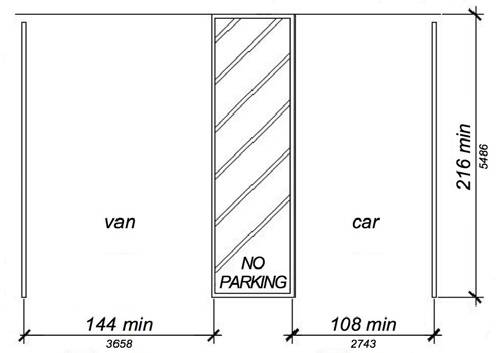
(a)
perpendicular parking
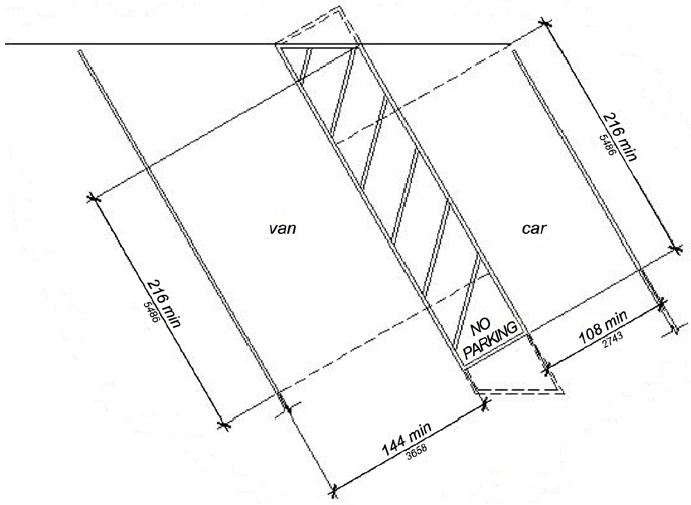
(b)
angled parking
FIGURE 11B-502.2 ‡‡
VEHICLE PARKING SPACES
11B-502.3 Access aisle.
Access aisles serving parking spaces shall comply with Section 11B-502.3. Access aisles shall adjoin an accessible route. Two parking spaces shall be permitted to share a common access aisle.
[2010 ADAS] Advisory 502.3 Access Aisle. Accessible routes must connect parking spaces to accessible entrances. In parking facilities where the accessible route must cross vehicular traffic lanes, marked crossings enhance pedestrian safety, particularly for people using wheelchairs and other mobility aids. Where possible, it is preferable that the accessible route not pass behind parked vehicles.
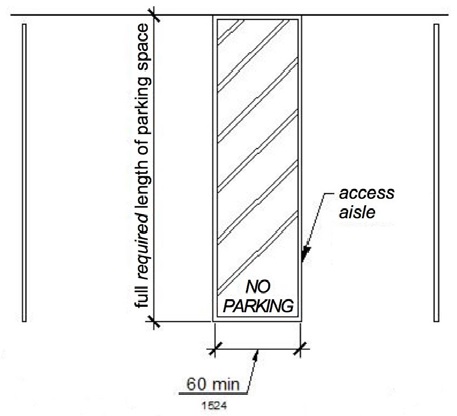
(a)
perpendicular parking
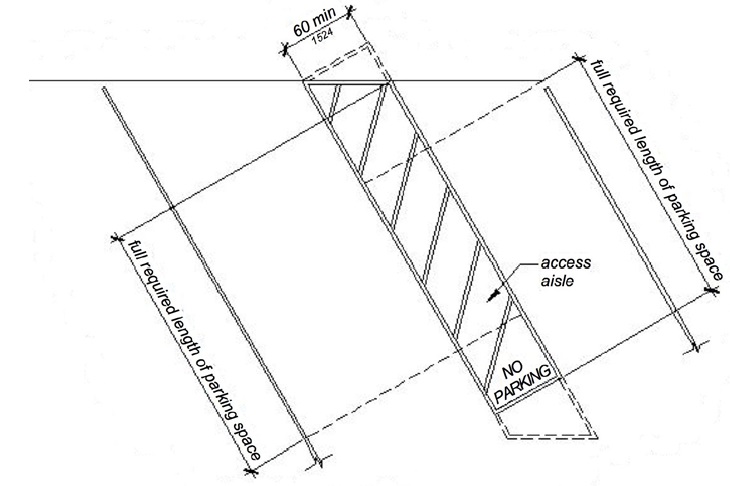
(b)
angled parking
FIGURE 11B-502.3 ‡‡
PARKING SPACE ACCESS AISLE
11B-502.3.1 Width.
Access aisles serving car and van parking spaces shall be 60 inches (1524 mm) wide minimum.
11B-502.3.2 Length.
Access aisles shall extend the full required length of the parking spaces they serve.
11B-502.3.3 Marking.
Access aisles shall be marked with a blue painted borderline around their perimeter. The area within the blue borderlines shall be marked with hatched lines a maximum of 36 inches (914 mm) on center in a color contrasting with that of the aisle surface, preferably blue or white. The words "NO PARKING" shall be painted on the surface within each access aisle in white letters a minimum of 12 inches (305 mm) in height and located to be visible from the adjacent vehicular way. Access aisle markings may extend beyond the minimum required length.
[2010 ADAS] 502.3.3 Marking. Access aisles shall be marked so as to discourage parking in them.
[2010 ADAS] Advisory 502.3.3 Marking. The method and color of marking are not specified by these requirements but may be addressed by State or local laws or regulations. Because these requirements permit the van access aisle to be as wide as a parking space, it is important that the aisle be clearly marked.

Asphalt is often the parking surface material used at accessible parking spaces. Asphalt is generally considered to be fairly dark in appearance. In order to provide a suitable contrasting color at the hatched area of the loading and unloading access aisle, a light color hatching should be used at locations where asphalt is the parking surface material. Although white paint is preferred (and traditionally the color most often used), its use is not mandatory under the California Building Code (CBC).
In order to provide a suitable contrast at the hatched area of the loading and unloading access aisle in locations where light concrete is used as the parking surface material (such as at concrete parking garages), a dark color hatching should be used. Although blue paint is preferred, its use is not mandatory under the California Building Code (CBC). ◼
ETA Editor's Note
The CBC marking requirements for accessible parking spaces and van accessible parking spaces are more extensive than those in 2010 ADAS.
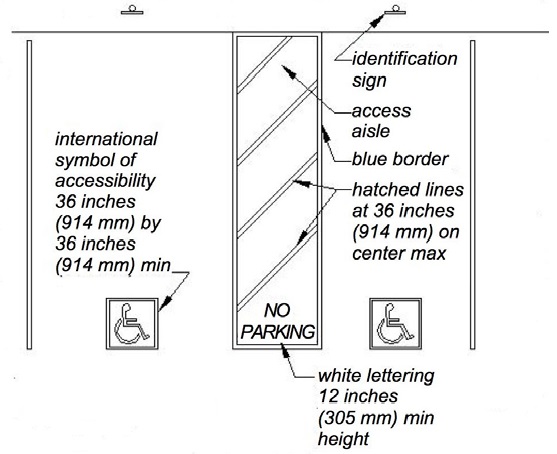
(a)
perpendicular parking
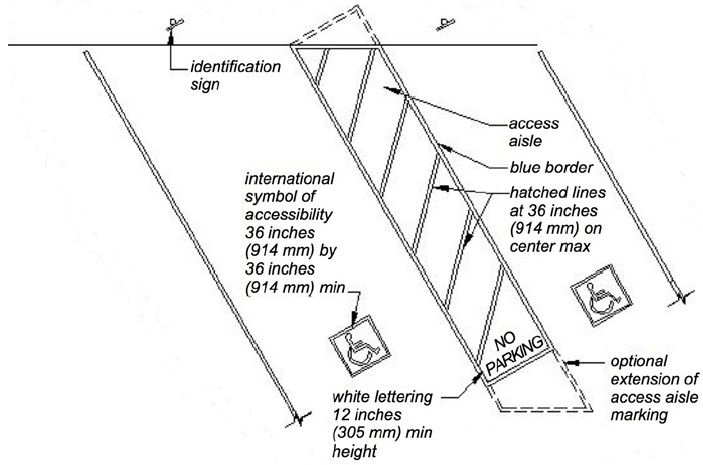
(b)
angled parking
FIGURE 11B-502.3.3 ‡‡
ANGLED AND PERPENDICULAR PARKING IDENTIFICATION
11B-502.3.4 Location.
Access aisles shall not overlap the vehicular way. Access aisles shall be permitted to be placed on either side of the parking space except for van parking spaces which shall have access aisles located on the passenger side of the parking spaces.
[2010 ADAS] 502.3.4 Location. Access aisles shall not overlap the vehicular way. Access aisles shall be permitted to be placed on either side of the parking space except for angled van parking spaces which shall have access aisles located on the passenger side of the parking spaces.
[2010 ADAS] Advisory 502.3.4 Location. Wheelchair lifts typically are installed on the passenger side of vans. Many drivers, especially those who operate vans, find it more difficult to back into parking spaces than to back out into comparatively unrestricted vehicular lanes. For this reason, where a van and car share an access aisle, consider locating the van space so that the access aisle is on the passenger side of the van space.
11B-502.4 Floor or ground surfaces.
Parking spaces and access aisles serving them shall comply with Section 11B-302. Access aisles shall be at the same level as the parking spaces they serve. Changes in level are not permitted.
Exception: Slopes not steeper than 1:48 shall be permitted.
[2010 ADAS] Advisory 502.4 Floor or Ground Surfaces. Access aisles are required to be nearly level in all directions to provide a surface for wheelchair transfer to and from vehicles. The exception allows sufficient slope for drainage. Built-up curb ramps are not permitted to project into access aisles and parking spaces because they would create slopes greater than 1:48.

11B-502.5 Vertical clearance.
Parking spaces, access aisles and vehicular routes serving them shall provide a vertical clearance of 98 inches (2489 mm) minimum.
[2010 ADAS] 502.5 Vertical Clearance. Parking spaces for vans and access aisles and vehicular routes serving them shall provide a vertical clearance of 98 inches (2490 mm) minimum.
[2010 ADAS] Advisory 502.5 Vertical Clearance. Signs provided at entrances to parking facilities informing drivers of clearances and the location of van accessible parking spaces can provide useful customer assistance.
ETA Editor's Note
CBC requires 98 inches minimum vertical clearance at all accessible parking spaces, not solely van accessible parking spaces. This is more stringent than 2010 ADAS.
11B-502.6 Identification.
Parking space identification signs shall include the International Symbol of Accessibility complying with Section 11B-703.7.2.1 in white on a blue background. Signs identifying van parking spaces shall contain additional language or an additional sign with the designation “van accessible.” Signs shall be 60 inches (1524 mm) minimum above the finish floor or ground surface measured to the bottom of the sign.
[2010 ADAS] 502.6 Identification. Parking space identification signs shall include the International Symbol of Accessibility complying with 703.7.2.1. Signs identifying van parking spaces shall contain the designation "van accessible." Signs shall be 60 inches (1525 mm) minimum above the finish floor or ground surface measured to the bottom of the sign.
[2010 ADAS] Advisory 502.6 Identification. The required "van accessible" designation is intended to be informative, not restrictive, in identifying those spaces that are better suited for van use. Enforcement of motor vehicle laws, including parking privileges, is a local matter.

Exception: Signs located within a circulation path shall be a minimum of 80 inches (2032 mm) above the finish floor or ground surface measured to the bottom of the sign.
11B-502.6.1 Finish and size.
Parking identification signs shall be reflectorized with a minimum area of 70 square inches (45,161 mm2).
11B-502.6.2 Minimum fine.
Additional language or an additional sign below the International Symbol of Accessibility shall state “Minimum Fine $250.”
11B-502.6.3 Location.
A parking space identification sign shall be visible from each parking space. Signs shall be permanently posted either immediately adjacent to the parking space or within the projected parking space width at the head end of the parking space. Signs may also be permanently posted on a wall at the interior end of the parking space.
11B-502.6.4 Marking.
Each accessible car and van space shall have surface identification complying with either Section 11B-502.6.4.1 or 11B-502.6.4.2.
11B-502.6.4.1 The parking space shall be marked with an International Symbol of Accessibility complying with Section 11B-703.7.2.1 in white on a blue background a minimum 36 inches wide by 36 inches high (914 mm by 914 mm) . The centerline of the International Symbol of Accessibility shall be a maximum of 6 inches (152 mm) from the centerline of the parking space, its sides parallel to the length of the parking space and its lower corner at, or lower side aligned with, the end of the parking space length.
11B-502.6.4.2 The parking space shall be outlined in blue or painted blue and shall be marked with an International Symbol of Accessibility complying with Section 11B-703.7.2.1 a minimum 36 inches wide by 36 inches high (914 mm by 914 mm) in white or a suitable contrasting color. The centerline of the International Symbol of Accessibility shall be a maximum of 6 inches (152 mm) from the centerline of the parking space, its sides parallel to the length of the parking space and its lower corner at, or lower side aligned with, the end of the parking space.
ETA Editor's Note
The CBC identification requirements for accessible parking spaces and van accessible parking spaces are more extensive than those in 2010 ADAS.
11B-502.7 Relationship to accessible routes.
Parking spaces and access aisles shall be designed so that cars and vans, when parked, cannot obstruct the required clear width of adjacent accessible routes.
[2010 ADAS] Advisory 502.7 Relationship to Accessible Routes. Wheel stops are an effective way to prevent vehicle overhangs from reducing the clear width of accessible routes.
11B-502.7.1 Arrangement.
Parking spaces and access aisles shall be designed so that persons using them are not required to travel behind parking spaces other than to pass behind the parking space in which they parked.

ETA Editor's Note
While 2010 ADAS Advisory 502.3 discourages configuring access aisles to require travel behind other parked vehicles, CBC 11B-502.7.1 prohibits this.
11B-502.7.2 Wheel stops.
A curb or wheel stop shall be provided if required to prevent encroachment of vehicles over the required clear width of adjacent accessible routes.
11B-502.8 Additional signs.
An additional sign shall be posted either; 1) in a conspicuous place at each entrance to an off-street parking facility or 2) immediately adjacent to on-site accessible parking and visible from each parking space.
11B-502.8.1 Size.
The additional sign shall not be less than 17 inches (432 mm) wide by 22 inches (559 mm) high.
11B-502.8.2 Lettering.
The additional sign shall clearly state in letters with a minimum height of 1 inch (25 mm) the following:
"Unauthorized vehicles parked in designated accessible spaces not displaying distinguishing placards or special license plates issued for persons with disabilities will be towed away at the owner’s expense. Towed vehicles may be reclaimed at _________________________ or by telephoning _______________________."
Blank spaces shall be filled in with appropriate information as a permanent part of the sign.

User Comments/Questions
Add Comment/Question